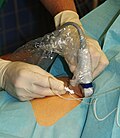Femoral nerve block
Femoral Nerve Block
A femoral nerve block is a medical procedure that involves the injection of local anesthetics near the femoral nerve to provide analgesia for surgeries and pain management, particularly in the anterior thigh and knee. This technique is widely used in orthopedic and trauma surgeries, facilitating postoperative pain control and reducing the need for systemic opioids.
Indications[edit]
The primary indication for a femoral nerve block is pain management. It is particularly beneficial for surgeries involving the lower extremity, such as:
- Total knee arthroplasty
- Anterior cruciate ligament reconstruction
- Fractures of the femur
- Procedures on the knee and anterior thigh
In addition to surgical indications, femoral nerve blocks are used in emergency medicine for pain control in patients with hip fractures and in chronic pain management for conditions affecting the femoral nerve distribution area.
Anatomy[edit]
The femoral nerve is the largest branch of the lumbar plexus, originating from the dorsal divisions of the L2 to L4 nerve roots. It descends through the fibers of the psoas major muscle, emerges from its lower part, and passes beneath the inguinal ligament into the thigh. It provides motor innervation to the anterior compartment of the thigh and sensory innervation to the anterior thigh and medial aspect of the leg.
Technique[edit]
The femoral nerve block is performed using either landmark-based techniques or under ultrasound guidance, which has become the preferred method due to its higher success rates and safety profile.
- Ultrasound-Guided Technique
1. The patient is placed in a supine position with the leg slightly externally rotated. 2. The ultrasound probe is placed below the inguinal ligament to visualize the femoral nerve, artery, and vein. 3. After identifying the femoral nerve, a needle is advanced in-plane or out-of-plane to the ultrasound probe towards the nerve. 4. Local anesthetic is injected around the nerve, ensuring proper spread without intravascular injection.
- Landmark-Based Technique
1. The inguinal crease is identified, and a point 1-2 cm lateral to the pulse of the femoral artery is marked. 2. A needle is inserted at this point and advanced perpendicularly until a loss of resistance is felt or a paresthesia is elicited in the nerve distribution area. 3. Local anesthetic is then injected after negative aspiration for blood.
Complications[edit]
While generally safe, femoral nerve blocks can be associated with complications such as:
- Infection
- Hematoma
- Nerve damage
- Intravascular injection
- Local anesthetic systemic toxicity (LAST)
Contraindications[edit]
Absolute contraindications include patient refusal and infection at the injection site. Relative contraindications involve coagulopathy, pre-existing neurological deficits, and severe systemic infection.
Conclusion[edit]
Femoral nerve blocks are a valuable tool in pain management, offering significant benefits in terms of pain control and reduction in opioid consumption. With advancements in ultrasound technology, the safety and efficacy of this procedure have improved, making it a preferred choice for many clinical indications.
-
Femoral nerve block
Ad. Transform your life with W8MD's Budget GLP-1 injections from $75


W8MD offers a medical weight loss program to lose weight in Philadelphia. Our physician-supervised medical weight loss provides:
- Weight loss injections in NYC (generic and brand names):
- Zepbound / Mounjaro, Wegovy / Ozempic, Saxenda
- Most insurances accepted or discounted self-pay rates. We will obtain insurance prior authorizations if needed.
- Generic GLP1 weight loss injections from $75 for the starting dose.
- Also offer prescription weight loss medications including Phentermine, Qsymia, Diethylpropion, Contrave etc.
NYC weight loss doctor appointmentsNYC weight loss doctor appointments
Start your NYC weight loss journey today at our NYC medical weight loss and Philadelphia medical weight loss clinics.
- Call 718-946-5500 to lose weight in NYC or for medical weight loss in Philadelphia 215-676-2334.
- Tags:NYC medical weight loss, Philadelphia lose weight Zepbound NYC, Budget GLP1 weight loss injections, Wegovy Philadelphia, Wegovy NYC, Philadelphia medical weight loss, Brookly weight loss and Wegovy NYC
|
WikiMD's Wellness Encyclopedia |
| Let Food Be Thy Medicine Medicine Thy Food - Hippocrates |
Medical Disclaimer: WikiMD is not a substitute for professional medical advice. The information on WikiMD is provided as an information resource only, may be incorrect, outdated or misleading, and is not to be used or relied on for any diagnostic or treatment purposes. Please consult your health care provider before making any healthcare decisions or for guidance about a specific medical condition. WikiMD expressly disclaims responsibility, and shall have no liability, for any damages, loss, injury, or liability whatsoever suffered as a result of your reliance on the information contained in this site. By visiting this site you agree to the foregoing terms and conditions, which may from time to time be changed or supplemented by WikiMD. If you do not agree to the foregoing terms and conditions, you should not enter or use this site. See full disclaimer.
Credits:Most images are courtesy of Wikimedia commons, and templates, categories Wikipedia, licensed under CC BY SA or similar.
Translate this page: - East Asian
中文,
日本,
한국어,
South Asian
हिन्दी,
தமிழ்,
తెలుగు,
Urdu,
ಕನ್ನಡ,
Southeast Asian
Indonesian,
Vietnamese,
Thai,
မြန်မာဘာသာ,
বাংলা
European
español,
Deutsch,
français,
Greek,
português do Brasil,
polski,
română,
русский,
Nederlands,
norsk,
svenska,
suomi,
Italian
Middle Eastern & African
عربى,
Turkish,
Persian,
Hebrew,
Afrikaans,
isiZulu,
Kiswahili,
Other
Bulgarian,
Hungarian,
Czech,
Swedish,
മലയാളം,
मराठी,
ਪੰਜਾਬੀ,
ગુજરાતી,
Portuguese,
Ukrainian

